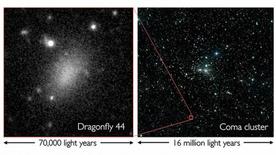
A fluffy galaxy is hard to find, but that didn’t stop a Yale astronomer and an international research team from identifying the fluffiest galaxies in the universe.
These “ultra diffuse” galaxies are located about 300 million light years from Earth, in the Coma cluster of galaxies. What makes them fluffy? It is this: although they are as wide as our own Milky Way galaxy, they harbor only 1% as many stars.
“If the Milky Way is a sea of stars, then these newly discovered galaxies are like wisps of clouds,” said Pieter van Dokkum, chair of the Department of Astronomy and lead author of a study published in the Astrophysical Journal Letters.
“We are beginning to form some ideas about how they were born and it’s remarkable they have survived at all,” van Dokkum said. “They are found in a dense, violent region of space filled with dark matter and galaxies whizzing around, so we think they must be cloaked in their own invisible dark matter ‘shields’ that are protecting them from this intergalactic assault.”
The research team included astronomers from San Jose State University, the University of Toronto, and the University of California-Santa Cruz. The team made its discovery by combining results from the Dragonfly Telephoto Array — which van Dokkum helped to invent — and the W.M. Keck Observatory’s 10-meter Keck I telescope.
- YaleNews press release by Jim Shelton